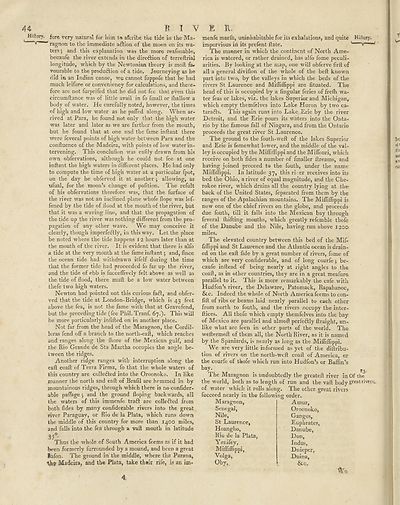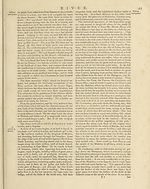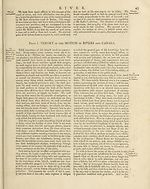Encyclopaedia Britannica, or, a Dictionary of arts, sciences, and miscellaneous literature : enlarged and improved. Illustrated with nearly six hundred engravings > Volume 18, RHI-SCR
(50) Page 44
Download files
Complete book:
Individual page:
Thumbnail gallery: Grid view | List view

R I V
fore very natural for him afcrxbe the tide in the Ma-
ragnon to the immediate aftion of the moon on its wa¬
ters •, and this explanation was the more reafonable,
becaufe the river extends in the direction of terreftrial
longitude, which by the Newtonian theory is moft far
vourable to the production of a tide. Journeying as he
did in an Indian canoe, ive. cannot fuppofe that he had
much leifure or conveniency for calculations, and there¬
fore are not furprifed that he did not fee that £ven this
circumftance was of little avail in fo fmall or (hallow a
body of water. He carefully noted, however, the times
of high and low water as he paflfed along. When ar¬
rived at Para, he found not only that the high water
was later and later as we are farther from the mouth,
but he found that at one and the fame inftant there
were feveral points of high water between Para and the
confluence of the Madeira, with points of low water in¬
tervening. This conclufion was eafily drawn from his
own obfervations, although he could not fee at one
inftant the high waters in different places. He had only
to compute the time of high water at a particular fpot,
on the day he obferved it at another j allowing, as
ufual, for the moon’s change of pofition. The refult
of his obfervations therefore was, that the furface of
the river was not an inclined plane vvhofe flope was lef-
fened by the tide of flood at the mouth of the river, but
that it was a waving line, and that the propagation of
the tide up the river was nothing different from the pro¬
pagation of any other wave. We may conceive it
clearly, though imperfeftly, in this way. Let the place
be noted where the tide happens 12 hours later than at
the mouth of the river. It is evident that there is alfo
a tide at the very mouth at the fame inftant j and, fince
the ocean tide had withdrawn itfelf during the time
that the former tide had proceeded fo far up the river,
and the tide of ebb is fucceflively felt above as well as
the tide of flood, there muft: be a low water between
thefe two high waters.
Newton had pointed out this curious faCI, and obfer¬
ved that the tide at London-Bridge, which is 43 feet
above the fea, is not the fame with that at Gravefend,
but the preceding tide (fee Phil. Tranf. 67.). This will
be more particularly infilled on in another place.
Not far from the head of the Maragnon, the Cordil¬
leras fend off a branch to the north-eaft, which reaches
and ranges along the fhore of the Mexican gulf, and
the Rio Grande de Sta Martha occupies the angle be¬
tween the ridges.
Another ridge ranges with interruption along the
caft coaft of Terra Firma, fo that the whole waters of
this country are colledled into the Oroonoko. In like
manner the north and eaft of Brafil are hemmed in by
mountainous ridges, through which there is no confider-
able paflage ; and the ground Hoping backwards, all
the waters of this immenfe tra6l are collefted from
both fides by many confide*able rivers into the great
river Paraguay, or Rio de la Plata, which runs down
the middle of this country for more than 1400 miles,
and falls into the fea through a vaft mouth in latitude
3J°-
Thus the whole of South America feems as if it had
been formerly furrounded by a mound, and been a great
ftafon. The ground in the middle, where the Parana,
Madeira, and the Plata, take their rife, is an im-
E R,
menfe marfh, uninhabitable for its exhalations, and quite Hiftory.
impervious in its prefent ftate. ‘—""v
The manner in which the continent of North Ame¬
rica is watered, or rather drained, has alfo fome peculi¬
arities. By looking at the map, one will obferve firft of
all a general divifion of the whole of the beft known
part into two, by the valleys in which the beds of the
rivers St Laurence and Mifliflippi are fituated. The
head of this is occupied by a Angular feries of frefh wa¬
ter feas or lakes, viz. the lakes Superior and Michigan,
which empty themfelves into Lake Huron by two ca~
tara£ls. This again runs into Lake Erie by the river
Detroit, and the Erie pours its waters into the Onta¬
rio by the famous fall of Niagara, and from the Ontario
proceeds the great river St Laurence.
The ground to the fouth-weft of the lakes Superior
and Erie is fomewhat lower, and the middle of the val¬
ley is occupied by the Mifliflippi and the Miffpuri, which
receive on both fides a number of fmaller fireams, and
having joined proceed to the fouth, under the name
Mifliflippi. In latitude 37, this ri er receives into its
bed the Ohio, a river of equal magnitude, and the Che¬
rokee river, which drains all the country lying at the
back of the United States, feparated from them by the
ranges of the Apalachian mountains. The Mifliflippi is
now one of the chief rivers on the globe, and proceeds
due fouth, till it falls into the Mexican bay through
feveral ftiifting mouths, which greatly refemble thofe
of the Danube and the Nile, having run above 120a
miles.
The elevated country between this bed of the Mif-
fiflippi and St Laurence and the Atlantic ocean is drain¬
ed on the eaft fide by a great number of rivers, fome of
which are very confiderable, and of long courfe; be¬
caufe intlead of being nearly at right angles to the
coaft, as in other countries, they are in a great meafure
parallel to it. This is more remarkably the cafe with
Hudfon’s river, the Delaware, Patomack, Rapahanoc,
&c. Indeed the whole of North America feems to eon-
fift of ribs or beams laid nearly parallel to each other
from north to fouth, and the rivers occupy the inter-
ftices. All thofe which empty themfelves into the bay
of Mexico are parallel and almoft perfedlly ftraight, un¬
like what are feen in other parts of the world. The
weftermoft of them all, the North River, as it is named
by the Spaniards, is nearly as long as the Mifliflippi.
We are very little informed as yet of the diftribu-
tion of rivers on the north-weft coaft of America, or
the courfe of thofe which run into Hudfon’s or Baffin’s
bay* . **
I he Maragnon is undoubtedly the greateft river in Of the
the world, both as to length of run and the vaft body great riveis;'
of water which it rolls along. The other great rivers
fucceed nearly in the following order.
Maragnon,
Senegal,
Nile,
St Laurence,
Hoangho,
Rio de la Plata,
Yenifey,
Miffiffippi,
Volga,
Oby,
Amur,
Oroonoko,
Ganges,
Euphrates,
Danube,
Don,
Indus,
Dnieper,
Duina,
&.C.
4
fore very natural for him afcrxbe the tide in the Ma-
ragnon to the immediate aftion of the moon on its wa¬
ters •, and this explanation was the more reafonable,
becaufe the river extends in the direction of terreftrial
longitude, which by the Newtonian theory is moft far
vourable to the production of a tide. Journeying as he
did in an Indian canoe, ive. cannot fuppofe that he had
much leifure or conveniency for calculations, and there¬
fore are not furprifed that he did not fee that £ven this
circumftance was of little avail in fo fmall or (hallow a
body of water. He carefully noted, however, the times
of high and low water as he paflfed along. When ar¬
rived at Para, he found not only that the high water
was later and later as we are farther from the mouth,
but he found that at one and the fame inftant there
were feveral points of high water between Para and the
confluence of the Madeira, with points of low water in¬
tervening. This conclufion was eafily drawn from his
own obfervations, although he could not fee at one
inftant the high waters in different places. He had only
to compute the time of high water at a particular fpot,
on the day he obferved it at another j allowing, as
ufual, for the moon’s change of pofition. The refult
of his obfervations therefore was, that the furface of
the river was not an inclined plane vvhofe flope was lef-
fened by the tide of flood at the mouth of the river, but
that it was a waving line, and that the propagation of
the tide up the river was nothing different from the pro¬
pagation of any other wave. We may conceive it
clearly, though imperfeftly, in this way. Let the place
be noted where the tide happens 12 hours later than at
the mouth of the river. It is evident that there is alfo
a tide at the very mouth at the fame inftant j and, fince
the ocean tide had withdrawn itfelf during the time
that the former tide had proceeded fo far up the river,
and the tide of ebb is fucceflively felt above as well as
the tide of flood, there muft: be a low water between
thefe two high waters.
Newton had pointed out this curious faCI, and obfer¬
ved that the tide at London-Bridge, which is 43 feet
above the fea, is not the fame with that at Gravefend,
but the preceding tide (fee Phil. Tranf. 67.). This will
be more particularly infilled on in another place.
Not far from the head of the Maragnon, the Cordil¬
leras fend off a branch to the north-eaft, which reaches
and ranges along the fhore of the Mexican gulf, and
the Rio Grande de Sta Martha occupies the angle be¬
tween the ridges.
Another ridge ranges with interruption along the
caft coaft of Terra Firma, fo that the whole waters of
this country are colledled into the Oroonoko. In like
manner the north and eaft of Brafil are hemmed in by
mountainous ridges, through which there is no confider-
able paflage ; and the ground Hoping backwards, all
the waters of this immenfe tra6l are collefted from
both fides by many confide*able rivers into the great
river Paraguay, or Rio de la Plata, which runs down
the middle of this country for more than 1400 miles,
and falls into the fea through a vaft mouth in latitude
3J°-
Thus the whole of South America feems as if it had
been formerly furrounded by a mound, and been a great
ftafon. The ground in the middle, where the Parana,
Madeira, and the Plata, take their rife, is an im-
E R,
menfe marfh, uninhabitable for its exhalations, and quite Hiftory.
impervious in its prefent ftate. ‘—""v
The manner in which the continent of North Ame¬
rica is watered, or rather drained, has alfo fome peculi¬
arities. By looking at the map, one will obferve firft of
all a general divifion of the whole of the beft known
part into two, by the valleys in which the beds of the
rivers St Laurence and Mifliflippi are fituated. The
head of this is occupied by a Angular feries of frefh wa¬
ter feas or lakes, viz. the lakes Superior and Michigan,
which empty themfelves into Lake Huron by two ca~
tara£ls. This again runs into Lake Erie by the river
Detroit, and the Erie pours its waters into the Onta¬
rio by the famous fall of Niagara, and from the Ontario
proceeds the great river St Laurence.
The ground to the fouth-weft of the lakes Superior
and Erie is fomewhat lower, and the middle of the val¬
ley is occupied by the Mifliflippi and the Miffpuri, which
receive on both fides a number of fmaller fireams, and
having joined proceed to the fouth, under the name
Mifliflippi. In latitude 37, this ri er receives into its
bed the Ohio, a river of equal magnitude, and the Che¬
rokee river, which drains all the country lying at the
back of the United States, feparated from them by the
ranges of the Apalachian mountains. The Mifliflippi is
now one of the chief rivers on the globe, and proceeds
due fouth, till it falls into the Mexican bay through
feveral ftiifting mouths, which greatly refemble thofe
of the Danube and the Nile, having run above 120a
miles.
The elevated country between this bed of the Mif-
fiflippi and St Laurence and the Atlantic ocean is drain¬
ed on the eaft fide by a great number of rivers, fome of
which are very confiderable, and of long courfe; be¬
caufe intlead of being nearly at right angles to the
coaft, as in other countries, they are in a great meafure
parallel to it. This is more remarkably the cafe with
Hudfon’s river, the Delaware, Patomack, Rapahanoc,
&c. Indeed the whole of North America feems to eon-
fift of ribs or beams laid nearly parallel to each other
from north to fouth, and the rivers occupy the inter-
ftices. All thofe which empty themfelves into the bay
of Mexico are parallel and almoft perfedlly ftraight, un¬
like what are feen in other parts of the world. The
weftermoft of them all, the North River, as it is named
by the Spaniards, is nearly as long as the Mifliflippi.
We are very little informed as yet of the diftribu-
tion of rivers on the north-weft coaft of America, or
the courfe of thofe which run into Hudfon’s or Baffin’s
bay* . **
I he Maragnon is undoubtedly the greateft river in Of the
the world, both as to length of run and the vaft body great riveis;'
of water which it rolls along. The other great rivers
fucceed nearly in the following order.
Maragnon,
Senegal,
Nile,
St Laurence,
Hoangho,
Rio de la Plata,
Yenifey,
Miffiffippi,
Volga,
Oby,
Amur,
Oroonoko,
Ganges,
Euphrates,
Danube,
Don,
Indus,
Dnieper,
Duina,
&.C.
4
Set display mode to:
![]() Universal Viewer |
Universal Viewer | ![]() Mirador |
Large image | Transcription
Mirador |
Large image | Transcription
Images and transcriptions on this page, including medium image downloads, may be used under the Creative Commons Attribution 4.0 International Licence unless otherwise stated. ![]()
| Permanent URL | https://digital.nls.uk/193019357 |
|---|
| Attribution and copyright: |
|
|---|
| Description | Ten editions of 'Encyclopaedia Britannica', issued from 1768-1903, in 231 volumes. Originally issued in 100 weekly parts (3 volumes) between 1768 and 1771 by publishers: Colin Macfarquhar and Andrew Bell (Edinburgh); editor: William Smellie: engraver: Andrew Bell. Expanded editions in the 19th century featured more volumes and contributions from leading experts in their fields. Managed and published in Edinburgh up to the 9th edition (25 volumes, from 1875-1889); the 10th edition (1902-1903) re-issued the 9th edition, with 11 supplementary volumes. |
|---|---|
| Additional NLS resources: |
|

